A study by CoinDesk shows blockchain tech will grow fast in the next years. It’s changing how we keep and protect digital info. Blockchain is a new way to keep things safe, open, and hard to change. It’s used in finance, healthcare, supply chains, and government.
What is Blockchain Technology? Blockchain is a digital system that keeps records without a single boss. It uses secret codes, peer-to-peer networks, and group agreement to work. This tech could change how we do business, manage data, and trust each other online.
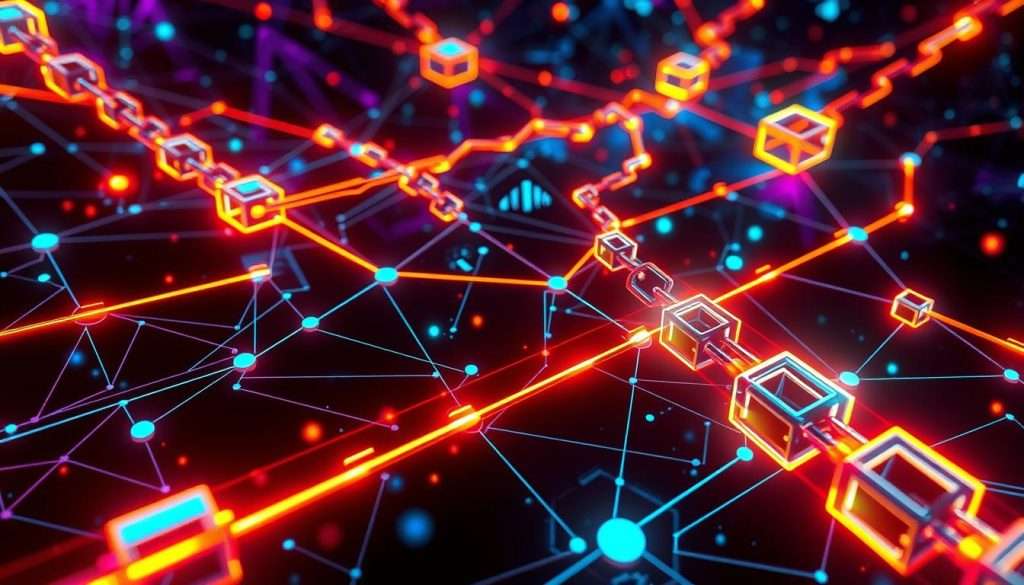
Key Takeaways
- Blockchain is a decentralized, distributed ledger technology that enables secure, transparent, and tamper-proof data storage and transactions.
- It was originally developed as the underlying framework for cryptocurrencies like Bitcoin and Ethereum, but has since found applications in various industries.
- Blockchain technology functions like a digital book shared across multiple computers, updated in real-time, and validated by a network of nodes.
- Key features of blockchain include enhanced security, transparency, and efficiency in data management and transactions.
- The blockchain technology market is witnessing growth as it offers secure, transparent, and tamper-proof data storage and transactions.
Understanding Blockchain Fundamentals
Blockchain technology started with distributed ledger tech. It has blocks, cryptographic hashes, and a network of peers. It uses advanced cryptography to keep transactions safe and data true.
Blockchain doesn’t need a central authority. This makes it safe from single failures and censorship.
The Evolution of Distributed Ledger Technology
Blockchain comes from distributed ledger tech (DLT). DLT lets a network of people share a record of transactions. This is different from old databases, where one person controls everything.
Core Components of Blockchain Architecture
The main parts of blockchain include:
- Blocks: These are the basic units of blockchain, holding transaction data and hashes.
- Cryptographic Hashes: These are math functions that keep data safe and true in the blockchain.
- Peer-to-Peer Network: This is the network of nodes that work together to keep the blockchain safe.
Key Characteristics of Blockchain Systems
Blockchain systems have special traits:
- Decentralization: Blockchain has no single point of control or failure.
- Immutability: Transactions on blockchain are hard to change, keeping data safe.
- Transparency: Blockchain’s work is open, making it easy to check.
These key points of blockchain tech have led to new uses in many fields. It’s changing how we handle digital stuff and deals.
“Blockchain technology is changing how we see data, deals, and the digital world’s future.”
What is Blockchain Technology
Blockchain is a digital ledger that can’t be changed and is shared. It uses many computers to keep data safe in different places. Each new transaction is added to a block, then linked to others, making a chain.
This system is different from old databases because it’s not controlled by one person. Blockchain is a decentralized way to share data and make transactions without middlemen.
Blockchain helps record transactions and track assets in a network. It can keep track of things you can touch (like houses) and things you can’t (like ideas). It makes sure each transaction is only recorded once, saving time and effort.
Smart contracts on blockchain can make rules for transactions, making things faster. But, if there’s an error, it needs a new transaction to fix it.
Blockchain networks make data safe and accurate for everyone in the network. There are many types of blockchain networks, like public and private ones. Companies must have good plans to keep blockchain safe.
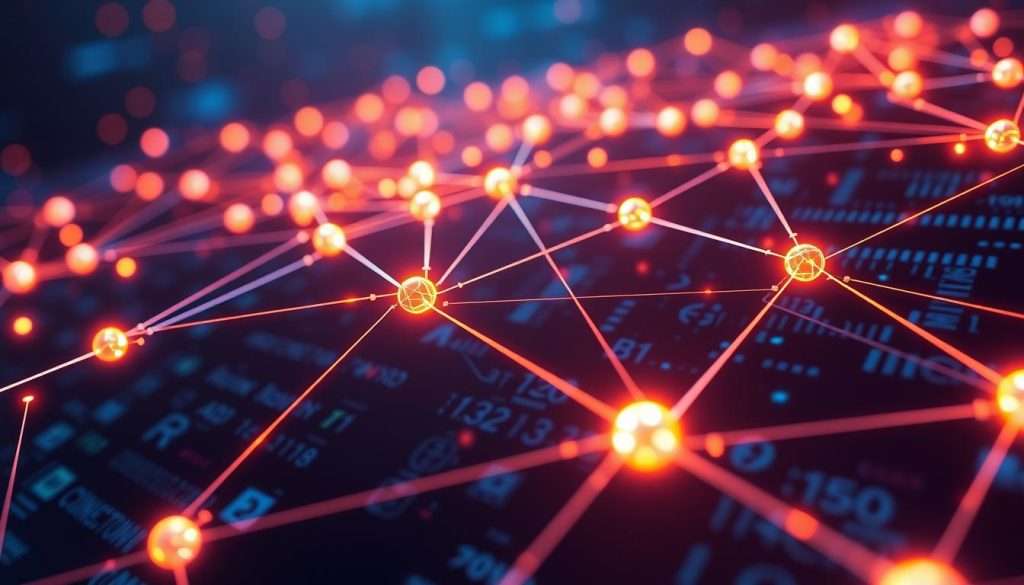
Blockchain is used in many fields like food, finance, and healthcare. It helps build trust and makes things more efficient. For example, a big financial deal was done in just hours, not days.
“Blockchain technology enables the creation of indelible audit trails and tracking of transactions to prevent data breaches.”
Companies use blockchain for smart contracts that work automatically and safely. But, some wonder if blockchain really adds value, even though it could change the game.
The Architecture of Blockchain Systems
Blockchain technology is changing how we store and manage data. It has a special design that makes it secure and open. Let’s explore the main parts of this design.
Block Structure and Components
Every block in a blockchain has important data like transactions and a timestamp. It also has a unique code called a hash. This hash connects each block to the next, making a strong chain.
This design keeps data safe. If someone tries to change a block, the network will know and stop it.
Cryptographic Hashing Mechanisms
Blockchain uses strong codes to keep it safe. Algorithms like SHA-256 turn data into a fixed, unique code. This makes sure data can’t be changed without being noticed.
Consensus Mechanisms Explained
The consensus mechanism is key to blockchain. It checks and adds new data to the ledger. Protocols like Proof of Work or Proof of Stake help everyone agree on the ledger’s state.
This ensures the blockchain is safe and reliable. It prevents bad actions and keeps data true and unchanged.
How Blockchain Transactions Work
Blockchain technology has changed how we do digital transactions. It makes sure each exchange is safe and true. Let’s explore how it works.
Blockchain transactions have four main steps. They start with a user’s request, then spread across a distributed network. Next, the network nodes check it. Finally, a new block is added to the blockchain. This careful validation process makes blockchain very secure.
- Transaction Request: It starts when a user sends a transaction, like a digital asset transfer. They use a blockchain app or wallet.
- Distribution Across the Network: The request is sent to the whole blockchain network. Many nodes receive it.
- Validation by Nodes: The nodes work together to check the transaction. They use special algorithms to make sure it’s real.
- Addition to the Blockchain: After it’s checked, a new block is added. This makes the transaction permanent and unchangeable.
The blockchain network is decentralized and uses strong cryptography. This makes it hard to change or fake blockchain transactions. This security is why blockchain is used in many fields.
| Key Factors Affecting Blockchain Transactions | Potential Impact |
|---|---|
| Transaction Size | Bigger transactions take longer and use more resources. |
| Transaction Timing | The time and network use can slow down processing. |
| Block Size | Block size affects how many transactions are processed at once. |
| Network Usage | Too much traffic can slow down the validation process and speed. |
Understanding blockchain transactions shows us its power. It’s a key technology for secure and open digital systems.
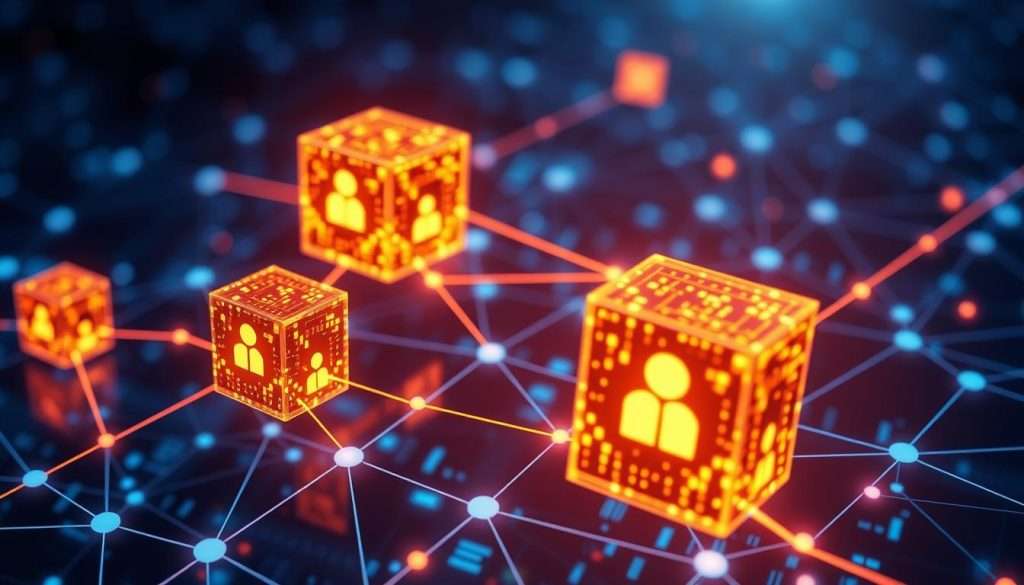
Types of Blockchain Networks
Blockchain technology is always changing. Knowing the different types of blockchain networks is key. Each type has its own features and is suited for different needs. Let’s look at the main differences between these blockchain types.
Public Blockchains
Public blockchains are very open and transparent. Anyone can join and help the network. But, they are also more open to attacks, as hackers could control the network.
As more people join, public blockchains can get slower. This makes them less scalable.
Private Blockchains
Private blockchains are run by one company and are not open to everyone. They are faster than public blockchains. Some say they’re not true blockchains because they’re controlled by one group.
But, they offer more privacy and security for companies.
Consortium and Hybrid Solutions
Consortium and hybrid blockchains are in between public and private. Consortium blockchains are run by a few groups. They are safer and more efficient than public blockchains.
But, they can still be at risk if one group is hacked. Hybrid blockchains mix public and private features. They offer more control and are faster than public blockchains.
Choosing a blockchain depends on many things. You need to think about openness, how it fits with your systems, and how fast it is. You also need to think about rules and keeping data safe. Working with a good blockchain partner can help make sure you use it right.
| Blockchain Type | Key Characteristics | Ideal Use Cases |
|---|---|---|
| Public Blockchain | Decentralized and transparent Vulnerable to 51% attacks Slower transaction speeds | Cryptocurrencies Decentralized finance (DeFi) Transparent supply chain management |
| Private Blockchain | Controlled by a single organization Enhanced privacy and security Faster transaction processing | Internal business processes Highly sensitive data management Streamlining organizational operations |
| Consortium Blockchain | Governed by a group of entities More secure and efficient than public blockchains Potential vulnerability if a member node is compromised | Supply chain management Cross-organizational collaborations Regulated industries (e.g., finance, healthcare) |
| Hybrid Blockchain | Combines features of public and private blockchains Customizable access levels Improved scalability over public blockchains | Enterprises with complex data and access requirements Scenarios requiring both public and private blockchain features Applications that need to balance transparency and privacy |
Blockchain Security Features
Blockchain technology is known for its strong security. It’s great for keeping and moving sensitive data and assets safely. At its heart, blockchain uses cryptography to make each block unique and unchangeable.
This makes it easy to spot any changes to the data. The hash value of a block changes if someone tries to alter it.
Blockchain’s security also comes from being decentralized. It’s spread out on many nodes worldwide. This makes it hard for hackers to attack because they need to get many nodes at once.
Blockchain is also immutable. Once data is on the blockchain, it can’t be changed without everyone agreeing. This keeps the data safe and true.
These features, along with cryptography and a decentralized network, make blockchain very secure. It’s used for many things, like money and supply chain management. With over $1 trillion in value in 2023, keeping blockchain safe is more important than ever.
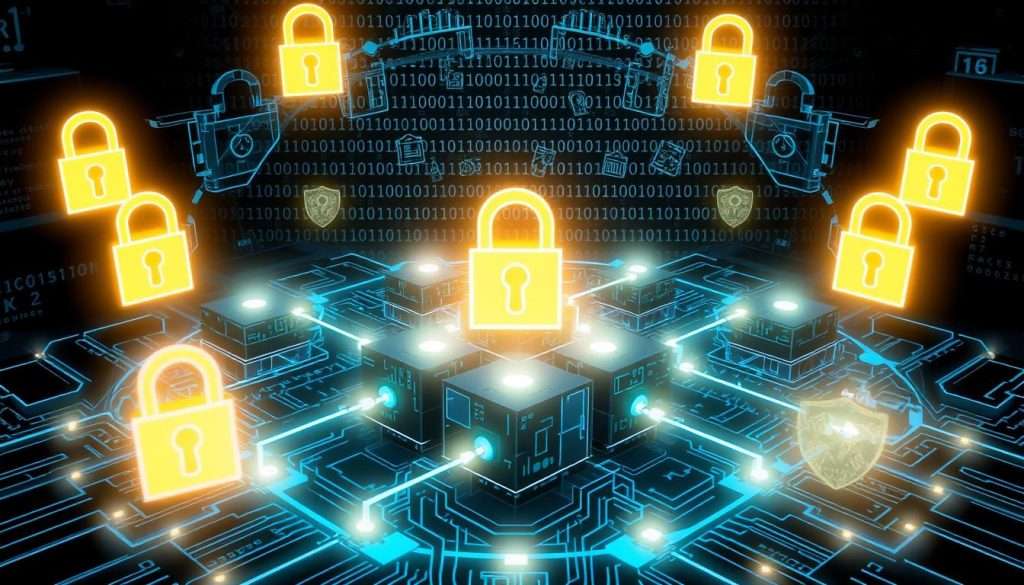
But, blockchain can still face attacks like Phishing, Routing, and Sybil attacks. There’s also the risk of a 51% attack where one group controls most of the network. To fight these, big blockchain solutions add extra security like identity checks and smart contract safety.
When making a blockchain solution, think about the governance, rules, identity, disaster plans, and security. This ensures the system stays safe and strong over time.
Smart Contracts and Decentralized Applications
Blockchain technology has changed how we do digital deals and agreements. Smart contracts and decentralized applications (DApps) are leading this change. They make blockchain useful for more than just digital money.
Understanding Smart Contracts
Smart contracts are digital deals that run on their own. They have rules written in code. This means they can make deals happen without needing someone in the middle.
They work by doing things when certain conditions are met. This makes them safe from fraud and outside interference. The deal’s actions are recorded on the blockchain and can’t be changed.
Smart contracts are used in many areas. This includes real estate, supply chains, business rules, and healthcare. They make things more efficient and reliable by cutting out the middleman.
DApps Development and Implementation
Decentralized applications (DApps) use blockchain for security and openness. They let users control their data and transactions better than regular apps.
Building DApps means creating smart contracts for the app’s main functions. Developers use different blockchain networks to make and share their DApps. They use proof of stake and proof of work to agree on the app’s rules.
Use Cases and Applications
Smart contracts and DApps are used in many fields. This includes finance, gaming, social media, and supply chains. In finance, they help with lending, borrowing, and staking. DApps like Aave and Uniswap change how we bank and manage assets.
In supply chains, they make things more open, traceable, and efficient. For example, IBM’s Blockchain Transparent Supply helps track medicines. This keeps the supply chain safe.
Smart contracts and DApps open up new ways to use blockchain. They make it possible for safe, decentralized interactions in many areas. As blockchain grows, we’ll see even more cool uses of smart contracts and decentralized applications.
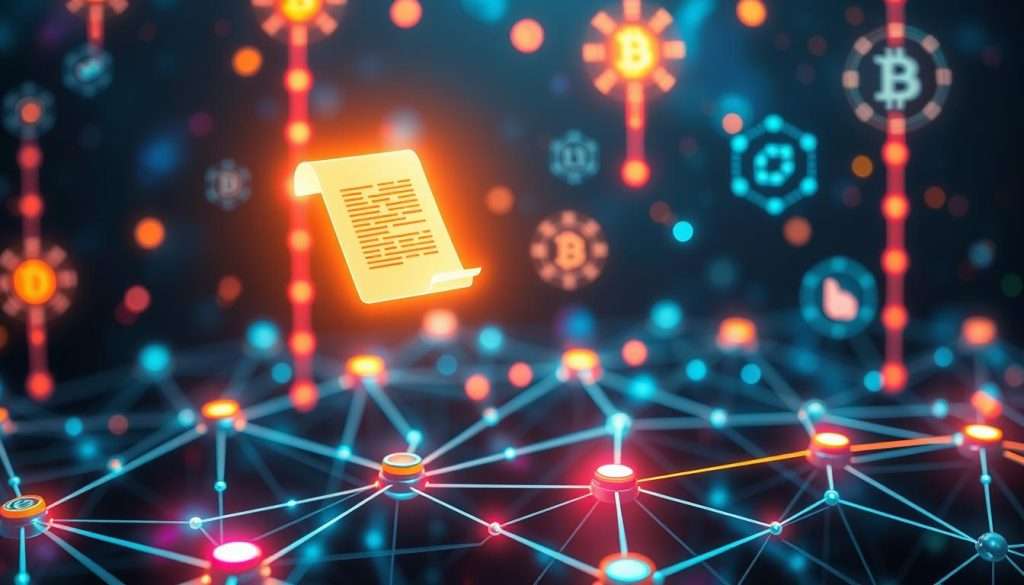
Blockchain vs Traditional Databases
Blockchain technology has changed how we manage data, challenging old ways. Traditional databases have been key for years. But blockchain databases offer new features that make them a good choice in some cases.
One big difference is centralization. Traditional databases are run by one person or group. Blockchain databases are spread out among many nodes. This makes blockchain data safer and more stable, unlike traditional databases.
Smart contracts in blockchain make it stand out. These contracts can do things on their own, cutting out middlemen. This is great for places where trust and clearness are key, like in finance or supply chains.
Choosing between blockchain and traditional databases depends on what you need. Blockchain is best for places needing openness, trust, and no single point of failure. Traditional databases are better for fast, big data needs.
As we move to Web 3.0, blockchain is becoming part of traditional databases. This shows how data management is changing. Both types will keep evolving, offering new ways to handle data.
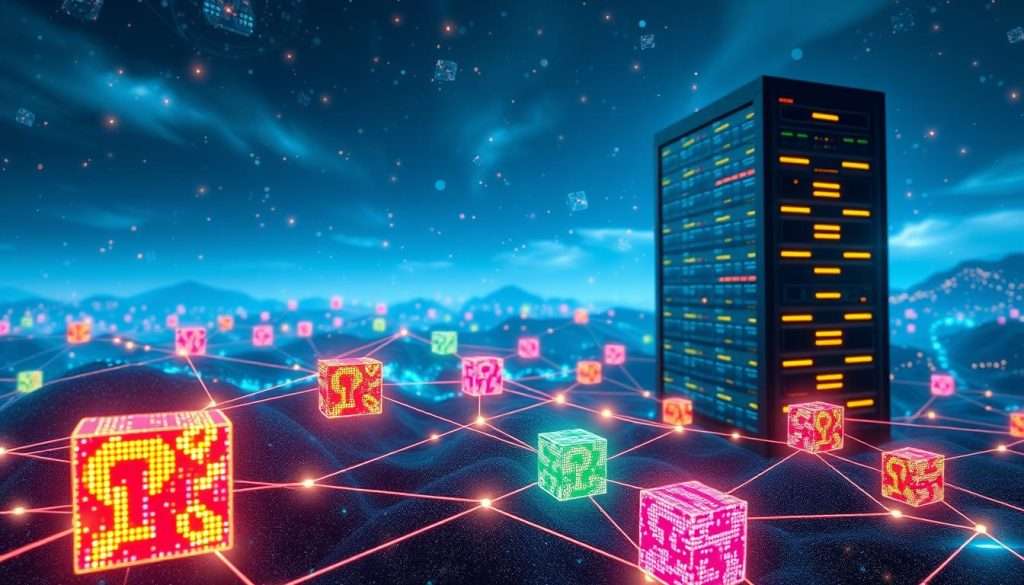
“Blockchain technology is revolutionizing the way we store and manage data, challenging the status quo of traditional databases and paving the way for a more secure, transparent, and decentralized future.”
Real-World Applications of Blockchain
Blockchain technology is changing many industries. It makes businesses work better. It brings security, transparency, and efficiency to areas like finance, supply chain, and healthcare.
Financial Services and Banking
Blockchain makes financial transactions faster and safer. It cuts down fraud and makes things clear. For example, JPMorgan Chase started a project in India to settle dollar transactions quickly.
Cash App lets users buy and sell bitcoin easily. This shows how blockchain is becoming part of our financial lives.
Supply Chain Management
Blockchain is making supply chains better. It makes tracking and sharing information easier. Companies like Xage Security and Helium are using it to secure IoT devices and create networks.
It helps with things like paying suppliers and tracking products. This makes supply chains more efficient.
Healthcare and Government Services
In healthcare, blockchain helps manage patient data safely. Novo Nordisk in Denmark uses it for clinical trials. Avaneer Health in Illinois uses it for sharing data in healthcare.
Government agencies are looking into blockchain for voting and identity management. It makes things more open and reduces the need for big systems.
FAQ
What is blockchain technology?
Blockchain is a new way to store data and make transactions. It’s like a digital book that many computers share. This technology is used for things like Bitcoin and Ethereum, but it’s also used in many other areas.
How does blockchain work?
It works like a digital book that many computers share. It gets updated in real-time. This makes data and transactions safe and clear.
What are the core components of blockchain architecture?
Blockchain has many parts. These include hardware, data, and nodes. Each block has data, a time stamp, and a special code. This code makes sure data is safe and blocks are linked.
What are the key characteristics of blockchain systems?
Blockchain is known for being open, safe, and clear. It uses special codes to keep data safe. This means no one person can control it, making it hard to cheat.
What are the different types of blockchain networks?
There are many types of blockchain networks. Some are open to everyone, while others are only for certain groups. There are also mixtures of these types.
How are blockchain transactions processed?
Transactions go through several steps. First, a request is made. Then, it’s shared across the network. Next, nodes check it. Finally, it’s added to the chain. This makes sure everything is safe and true.
What are the security features of blockchain?
Blockchain is very secure. It uses special codes and is spread out. This makes it hard to change data once it’s recorded.
What are smart contracts and decentralized applications (DApps)?
Smart contracts are like self-running contracts. They make deals without needing anyone in the middle. DApps are apps built on blockchain. They are safe and open to everyone.
How does blockchain differ from traditional databases?
Blockchain is different because it’s not controlled by one person. It’s safer and more open. Traditional databases are controlled by one person and need to be backed up.
What are the real-world applications of blockchain technology?
Blockchain is used in many areas. It makes money transactions faster and safer. It also helps with tracking goods and keeping patient data safe. Governments are even using it for voting and keeping records.

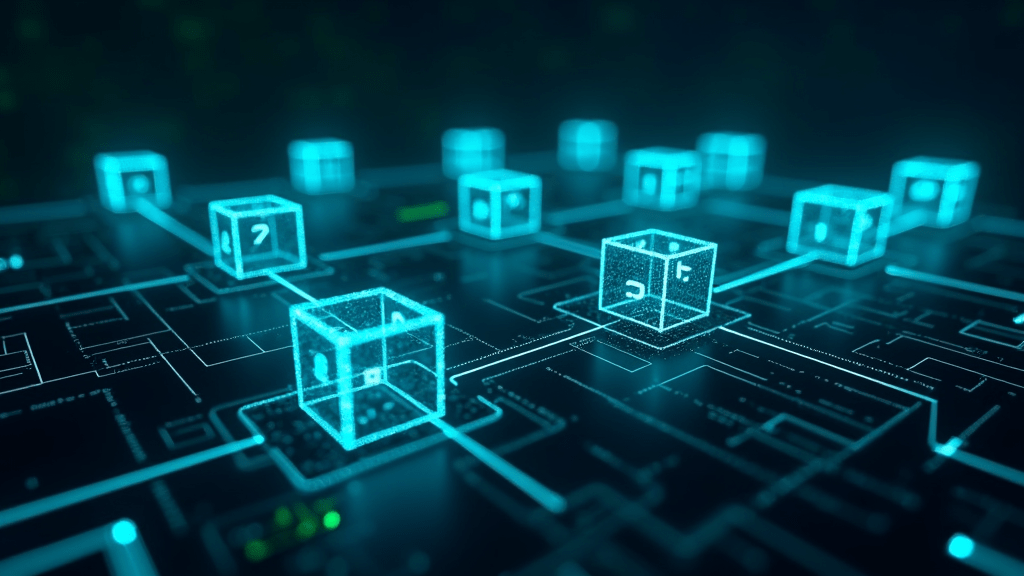
One Response